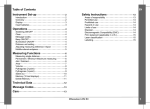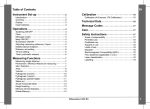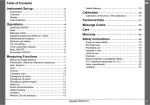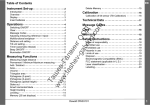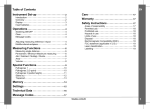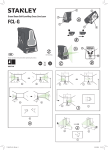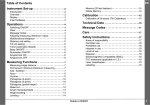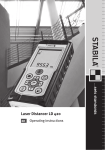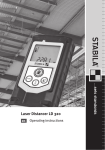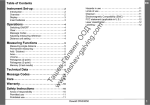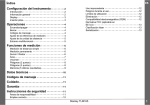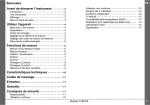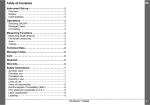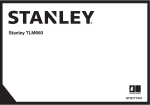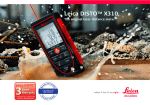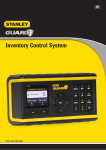Download 1 Table of Contents
Transcript
Table of Contents Instrument Set-up - - - - - - - - - - - - - - - - - - - - - - - 2 Introduction- - - - - - - - - - - - - - - - - - - - - - - - - - - - - - - 2 Overview - - - - - - - - - - - - - - - - - - - - - - - - - - - - - - - - 2 Display - - - - - - - - - - - - - - - - - - - - - - - - - - - - - - - - - - 3 Insert batteries - - - - - - - - - - - - - - - - - - - - - - - - - - - - 3 Operations - - - - - - - - - - - - - - - - - - - - - - - - - - - - - - 4 Switching ON/OFF - - - - - - - - - - - - - - - - - - - - - - - - - 4 Clear - - - - - - - - - - - - - - - - - - - - - - - - - - - - - - - - - - - 4 Message Codes - - - - - - - - - - - - - - - - - - - - - - - - - - - 4 Adjusting measuring reference - - - - - - - - - - - - - - - - - 4 Distance unit setting - - - - - - - - - - - - - - - - - - - - - - - - 5 Multifunctional endpiece- - - - - - - - - - - - - - - - - - - - - - 5 EN Prohibited use - - - - - - - - - - - - - - - - - - - - - - - - - - - -12 Hazards in use - - - - - - - - - - - - - - - - - - - - - - - - - - -12 Limits of use - - - - - - - - - - - - - - - - - - - - - - - - - - - - -12 Disposal - - - - - - - - - - - - - - - - - - - - - - - - - - - - - - - -12 Electromagnetic Compatibility (EMC) - - - - - - - - - - - -12 FCC statement (applicable in U.S.) - - - - - - - - - - - - -13 Laser classification- - - - - - - - - - - - - - - - - - - - - - - - -13 Labelling - - - - - - - - - - - - - - - - - - - - - - - - - - - - - - - -13 Measuring Functions - - - - - - - - - - - - - - - - - - -6 Measuring single distance - - - - - - - - - - - - - - - - - - - - 6 Permament measuring- - - - - - - - - - - - - - - - - - - - - - - 6 Add / Subtract - - - - - - - - - - - - - - - - - - - - - - - - - - - - - 6 Area- - - - - - - - - - - - - - - - - - - - - - - - - - - - - - - - - - - - 7 Volume- - - - - - - - - - - - - - - - - - - - - - - - - - - - - - - - - - 7 Pythagoras (2-point) - - - - - - - - - - - - - - - - - - - - - - - - 8 Pythagoras (3-point) - - - - - - - - - - - - - - - - - - - - - - - - 8 Memory (5 last results) - - - - - - - - - - - - - - - - - - - - - - 9 Technical Data - - - - - - - - - - - - - - - - - - - - - - - - - 10 Message Codes - - - - - - - - - - - - - - - - - - - - - - - - 11 Care - - - - - - - - - - - - - - - - - - - - - - - - - - - - - - - - - - - - 11 Warranty - - - - - - - - - - - - - - - - - - - - - - - - - - - - - - - 11 Safety Instructions - - - - - - - - - - - - - - - - - - - - - 11 Areas of responsibility - - - - - - - - - - - - - - - - - - - - - - 11 Permitted use - - - - - - - - - - - - - - - - - - - - - - - - - - - - 12 Stanley TLM165 1 EN Instrument Set-up Introduction Overview The safety instructions and the user manual should be read through carefully before the product is used for the first time. The person responsible for the product must ensure that all users understand these directions and adhere to them. Display The symbols used have the following meanings: WARNING Indicates a potentially hazardous situation or an unintended use which, if not avoided, will result in death or serious injury. CAUTION Indicates a potentially hazardous situation or an unintended use which, if not avoided, may result in minor injury and/or appreciable material, financial and environmental damage. Important paragraphs which must be adhered to in practice as they enable the product to be used in a technically correct and efficient manner. i 2 On / Measure / Tracking Area / Volume / Pythagoras/ Memory Measuring reference / Unit Stanley TLM165 Add / Subtract Clear / Off Instrument Set-up Display Battery Area / Volume EN Insert batteries i Pythagoras Memory To ensure a reliable use, do not use zinc-carbon batteries. Change batteries when battery symbol is flashing. Measuring reference Info Min/Max Measuring Addition / Subtraction Units Main line Stanley TLM165 3 EN Operations Switching ON/OFF Clear Message Codes 1x 2 sec Device is turned OFF. If the info icon appears with a number, observe the instructions in section "Message Codes". Example: Undo last action. Adjusting measuring reference 1 2 Distance is measured from the front of the device. Distance is measured from the pin of the endpiece. 3 Distance is measured from the rear of the device (standard setting). 4 Stanley TLM165 Operations Distance unit setting EN Switch between the following units: 2 sec 0.000m 0'00" 1/16 0 in 1/16 Multifunctional endpiece Stanley TLM165 5 EN Measuring Functions Measuring single distance 1 2 i 3 8.532 m Aim active laser at target. Target surfaces: Measuring errors can occur when measuring to colourless liquids, glass, styrofoam or semi-permeable surfaces or when aiming at high gloss surfaces. Against dark surfaces the measuring time increases. Permament measuring The last value measured is displayed. 2 1 3 2 sec Stops permanent measuring. 8.532 m Aim active laser at target. Add / Subtract 1x 1 2 7.332 m 6 2x i 3 The next measurement is added to the previous one. The next measurement is subtracted from the previous one. 5.5I5 m I2.847 m Stanley TLM165 The result is shown in the main line and the measured value above. This process can be repeated as required. The same process can be used for adding or subtracting areas or volumes. Measuring Functions Area EN 1x 1 2 3 4 Aim laser at first target point. i 5 Aim laser at second target point. 24.352 m The result is shown in the main line and the measured value above. 2 Volume 2x 1 2 3 Aim laser at first target point. i 7 78.694 m 4 5 Aim laser at second target point. 6 Aim laser at third target point. The result is shown in the main line and the measured value above. 3 Stanley TLM165 7 EN Measuring Functions Pythagoras (2-point) 3x 1 2 3 4 Aim laser at upper point. i 5 Aim laser rectangular at lower point. 8.294 m The result is shown in the main line and the measured distance above. Pressing the measuring key for 2 sec in the function activates automatically Minimum or Maximum measurement. Pythagoras (3-point) 4x 1 2 3 4 Aim laser at upper point. 8.294 m 8 Aim laser at rectangular point. i 7 5 The result is shown in the main line and the measured distance above. Pressing the measuring key for 2 sec in the function activates automatically Minimum or Maximum measurement. Stanley TLM165 6 Aim laser at lower point. Measuring Functions Memory (5 last results) EN 5x 1 2 5 8.294 m 5 last results are displayed. 5 8.294 m Navigates trough 5 last results. Stanley TLM165 9 EN Technical Data Distance measurement Typical Measuring Tolerance* ± 1.5 mm / 0.06 in *** Maximum Measuring Tolerance** ± 3.0 mm / 0.12 in *** Range at Target Plate 50 m / 164 ft Typical Range* 40 m / 132 ft Range at unfavourable condi- 35 m / 115 ft tion **** Smallest unit displayed 1 mm / 1/16 in Ø laser point at distances 6 / 30 mm (10 / 50 m) * applies for 100 % target reflectivity (white painted wall), low background illumination, 25 ºC ** applies for 10 to 500 % target reflectivity, high background illumination, -10 ºC to 50 ºC *** Tolerances apply from 0.05 m to 10 m with a confidence level of 95%. The maximum tolerance may deteriorate to 0.15 mm/m between 10 m to 30 m and to 0.2 mm/m for distances above 30 m **** applies for 100 % target reflectivity, background illumination of approximately 30'000 lux General Laser class 2 Laser type 635 nm, < 1 mW Protection class IP54 (dust- and splash water protected) Autom. laser switch off after 90 s Autom. power switch-off after 180 s Battery durability (2 x AAA) up to 3000 measurements Dimension (H x D x W) 104 x 58.8 x 29.6 mm 4.25 x 2.31 x 1.17 in Weight (with batteries) 100 g / 3.53 oz Temperature range: - Storage - Operation 10 -25 to 70 °C -13 to 158 °F 0 to 40 °C 32 to 104 °F Stanley TLM165 Functions Distance measuring yes Min/Max measuring yes Permanent measuring yes Addition/Subtraction yes Area yes Volume yes Pythagoras 2-point, 3-point Memory 5 results Message Codes Care Safety Instructions If the message Error does not disappear after switching on the device repeatedly, contact the dealer. If the message InFo appears with a number, press the Clear button and observe the following instructions: • Clean the device with a damp, soft cloth. • Never immerse the device in water. • Never use aggressive cleaning agents or solvents. The person responsible for the instrument must ensure that all users understand these directions and adhere to them. No. Cause Correction 204 Calculation error Perform measurement again. 252 Temperature too high Let device cool down. 253 Temperature too low Warm device up. 255 Received signal too Change target surface weak, measuring (e.g. white paper). time too long 256 Received signal too Change target surface high (e.g. white paper). 257 Too much background light Shadow target area. 258 Measurement outside of measuring range Correct range. 260 Laser beam interrupted Repeat measurement. EN Areas of responsibility Warranty Responsibilities of the manufacturer of the original equipment: The Stanley TLM has a two-year warranty. Stanley Tools For further information on this, contact 701 E. Joppa Road your dealer. Subject to change (drawings, descriptions Towson, Maryland 21286 and technical data). www.STANLEYLASERS.com www.STANLEYTOOLS.com www.STANLEYTOOLS.eu The company above is responsible for supplying the product, including the User Manual in a completely safe condition. The company above is not responsible for third party accessories. Responsibilities of the person in charge of the instrument: • To understand the safety instructions on the product and the instructions in the User Manual. • To be familiar with local safety regulations relating to accident prevention. • Always prevent access to the product by unauthorised personnel. Stanley TLM165 11 EN Safety Instructions Permitted use Hazards in use Disposal • Measuring distances • Tilt measurement WARNING CAUTION Prohibited use • • • • • • • • • Watch out for erroneous measurements if the instrument is defective or if it has been Using the product without instruction dropped or has been misused or modified. Using outside the stated limits Carry out periodic test measurements. Deactivation of safety systems and Particularly after the instrument has been removal of explanatory and hazard subject to abnormal use, and before, labels Opening of the equipment by using tools during and after important measurements. (screwdrivers, etc.) CAUTION Carrying out modification or conversion Never attempt to repair the product yourof the product Use of accessories from other manufac- self. In case of damage, contact a local dealer. turers without express approval Deliberate dazzling of third parties; also WARNING in the dark Inadequate safeguards at the surveying Changes or modifications not expressly approved could void the user’s authority to site (e.g. when measuring on roads, operate the equipment. construction sites, etc.) Deliberate or irresponsible behaviour on Limits of use scaffolding, when using ladders, when Refer to section "Technical data". measuring near machines which are The device is designed for use in running or near parts of machines or areas permanently habitable by installations which are unprotected humans. Do not use the product in exploAiming directly in the sun sion hazardous areas or in aggressive environments. i • 12 Stanley TLM165 Flat batteries must not be disposed of with household waste. Care for the environment and take them to the collection points provided in accordance with national or local regulations. The product must not be disposed with household waste. Dispose of the product appropriately in accordance with the national regulations in force in your country. Adhere to the national and country specific regulations. Product specific treatment and waste management can be downloaded from our homepage. Electromagnetic Compatibility (EMC) WARNING The device conforms to the most stringent requirements of the relevant standards and regulations. Yet, the possibility of causing interference in other devices cannot be totally excluded. Safety Instructions FCC statement (applicable in U.S.) This equipment has been tested and found to comply with the limits for a Class B digital device, pursuant to part 15 of the FCC Rules. These limits are designed to provide reasonable protection against harmful interference in a residential installation.This equipment generates, uses and can radiate radio frequency energy and, if not installed and used in accordance with the instructions, may cause harmful interference to radio communications. However, there is no guarantee that interference will not occur in a particular installation. If this equipment does cause harmful interference to radio or television reception, which can be determined by turning the equipment off and on, the user is encouraged to try to correct the interference by one or more of the following measures: • Reorient or relocate the receiving antenna. • Increase the separation between the equipment and receiver. • Connect the equipment into an outlet on a circuit different from that to which the receiver is connected. • Consult the dealer or an experienced radio/TV technician for help. EN Laser classification Labelling Laser Radiation Do not stare into the beam Laser class 2 acc. IEC 60825-1:2007 Maximum radiant power: <1mW Emitted wavelength: 620-690nm Beam divergence: 0.16 x 0.6 mrad Impulse duration: 0.2 x 10-9s - 0.8 x 10-9s The device produces visible laser beams, which are emitted from the instrument: It is a Class 2 laser product in accordance with: • IEC60825-1 : 2007 „Radiation safety of laser products“ Laser Class 2 products: Do not stare into the laser beam or direct it towards other people unnecessarily. Eye protection is normally afforded by aversion responses including the blink reflex. WARNING Looking directly into the beam with optical aids (e.g. binoculars, telescopes) can be hazardous. CAUTION Looking into the laser beam may be hazardous to the eyes. a Attach the laser sticker (a) of your country language. Stanley TLM165 13













